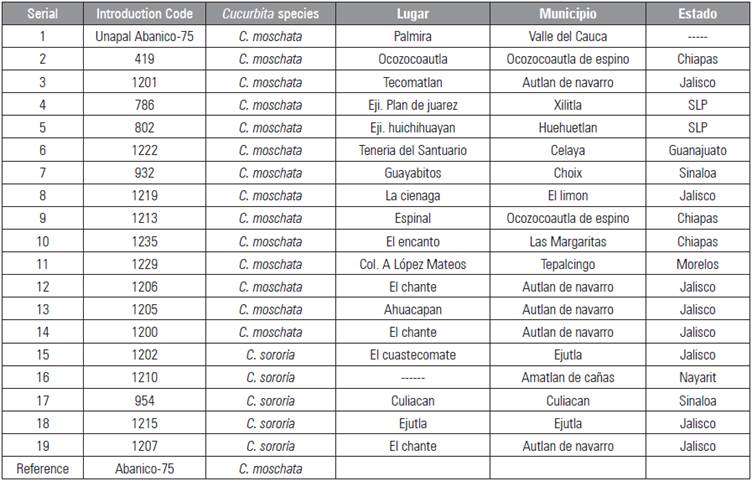INTRODUCTION
Identification of the place of origin has been the main research topic in Cucurbitas; however, little is known about the seed as a source of energy despite its high content of ethereal extract (Rodríguez et al., 2018). The sororia subspecies includes wild populations with a broad distribution, from Mexico to Nicaragua, which is the wild ancestor of the domesticated spe cies C. argyrosperma. The fruits are white with green and have varied sizes. The pericarp is usually coria ceous and is hard to fracture even with a percussion tool, with a bufoid pericarp and bedding (Valdés et al., 2014). The mesocarp can be colorless in some intro ductions; in others, it has an intense yellow color and bitter taste. Some fruits have a salmon-yellow meso-carp, which, upon, contact with air turns from deep green to completely black in a few minutes after re moving the seeds, as seen in C. moschata (Hidalgo and Vallejo, 2014). C. moschata is a domesticated species in South America. Although there is no agreement on the precise area of its domestication, it has been men tioned that northern Colombia is possibly the center of origin (Ortiz et al., 2013). The seeds have differ ent shades of coloration in the testa, ranging from havana to coffee with golden edges; the fruits usually have a soft pericarp, which can be smooth or curled, with soft bufoids, sardines, particular colors, one or two colors in bands or spots and variable format. The mesocarp is orange, ranging from pale orange to deep orange. The matrix has an intense orange; some ma trices, upon contact with air, become intense green (Hidalgo and Vallejo, 2014).
The economic value of tropical pastures -the basis of nutrition for cattle, goats, and sheep- has been wide ly documented (McIlroy, 1973; Roy, 2000; Ramírez et al., 2012; Sánchez et al., 2015). However, the for age that has been used to feed animals in the tropics lacks protein and energy (Cook et al., 2005; Holguín et al. 2015) and must be supplemented with agro-industrial raw materials or cereal and legume grains. New genotypes must be identified that can replace the available feed resources to ensure balanced live stock production, enhancing animal performance while reducing the need to use costly imported grains (Ortiz et al., 2013).
Ruminants, for example, are capable of degrading low-quality forage that is rich in plant cell walls, which is not suitable for feeding most monogastric animals that have enzymatic digestive processes (Pereira et al., 2015) because of multiple symbiotic, physical and mechanical associations that occur in the diges tive tract, specifically in the rumen (McSweeney and Mackie, 2012). Starch is fermented into volatile fatty acids and nitrogen sources that are degraded to ketoacids and ammonia, the latter being the main source of N for microbial synthesis (Nikkhah, 2015). The intensity of this degradation process varies, de pending on the magnitude of the potential degradable fraction and the retention time in the rumen as a function of forage quality, the amount of ammonia in the substrate and the available energy derived from high-quality grains, which degrade more quickly and yield more nutrients for cattle, improving the nutri tional efficiency (Olabisi, 2015). Therefore, research is needed on a new source of nutrients for animals, such as Cucurbita Spp seeds.
The whole seed meal (WSM) from squash cultivar Abanico-75 contained 36.25 ± 3.25% ether extract (EE), which was composed of 55.28% unsaturated fatty acids (of which 55.11% was linoleic acid). The defatted seed meal (DSM) contained 51.1 ± 0.95% protein and 4604.66 ± 134.08 kcal kg-1 crude ener gy (CE). The seed starch content ranged from 13 to 28% (Valdés et al., 2014). In 2009 and 2013, the Veg etables Research Group of the Universidad Nacional de Colombia-Palmira campus studied a collection of butternut squash (Cucurbita moschata Duch.) geno types from Central America to determine whether the nutritional composition in the WSM and DSM was sufficiently variable to select superior genotypes for farmers or animal feed (Valdés et al. 2014; Ortiz et al., 2013).
The present study aimed to identify squash geno types with a high nutritional value in WSM and DSM in a group of introductions that belong to the Vegetable Research Program's work collection of the Universidad Nacional de Colombia-Palmira campus.
MATERIALS AND METHODS
Trial site
The experiment was carried out during the first se mester of 2017 on the Mario Gonzales Aranda Experi mental Farm and in the Seeds and Animal Nutrition Labs of the Universidad Nacional de Colombia, located in the municipality of Palmira, Colombia (03°30'26.8'' N 76° 18'47.6'' W; average annual tem perature, 24°C; 1,000 m a.s.l.; average annual precipi tation, 1,000 mm) (Valdés et al., 2010).
Biological study materials
The WSM and DSM came from 19 squash introduc tions: 14 butternut squash (Cucurbita moschata) in troductions from Colombia and 5 introductions of a wild Mexican gourd (Cucurbita sororia), which belong to the Vegetable Research Program's work collection, Universidad Nacional de Colombia-Palmira Campus (Tab. 1). The WSM and DFM made from the fruit of squash cultivar Unapal Abanico-75 were used as the reference.
Seed treatment protocol. All squash seed samples were lyophilized and minced in a 2-blade Wiley Mill to obtain 1 mm-sized particles. The EE of the ground and lyophilized WSM and DSM was determined us ing a Soxhlet extractor, preserved separately in 50 ml Eppendorf tubes kept under refrigerated conditions (between 4 and 12°C) for a subsequent quality analy sis based on complete proximate analysis, along with fiber analysis using the Van Soest method (Tab. 2).
Selection of introductions for their nutritional value
The results of the proximate and fiber analyses were used to select the introductions with the highest nu tritional value in the WSM and DSM. The weighted selection index (WSI) was used (Roy, 2000; Valdés et al., 2014) as follows: (1), where WSI
(k)
was the stan dardized selection index for the k-th introduction (k: 1,2,3...), P
i
was the weighted factor assigned to i-th descriptor  was the average of the i-th descriptor in the k-th introduction,
was the average of the i-th descriptor in the k-th introduction,  was the overall average of the collection for the i-th descriptor, and S
g(i)
was the overall standard deviation of the i-th descriptor considering the k introductions.
was the overall average of the collection for the i-th descriptor, and S
g(i)
was the overall standard deviation of the i-th descriptor considering the k introductions.
The WSI value was calculated for each of the 19 in troductions based on the following characteristics: ash content, crude protein (CP) and EE in the WSM and ash content, CP and CE in the DSM. The weight ing factor Pi was assumed to be 0.33 and was equal for all variables, based on the assumption of equality of relative importance when studying an introduc tion for animal nutrition purposes.
Selecting introductions by relative feed value
The protocol of Hoffman and Combs (2014) was followed to determine the relative feed value (RFV) of each introduction. The fiber analysis, in terms of neutral detergent fiber (NDF) and acid detergent fiber (ADF), was used to determine the feed value and for age quality. The following general model was used:
where DDM was digestible dry matter = 88.9 - (0.779 x % ADF) and DMI was dry matter intake (% live-weight) = 120 / (% NDF).
The data were processed using Excel and subsequent ly analyzed using the SAS (statistical analysis soft ware) statistical package (SAS, 2013).
RESULTS AND DISCUSSION
Proximate characterization of the squash whole seed meal and defatted seed meal
The dry matter content of the WSM was higher than that of the DSM, probably because the DSM compo nents (sugars, starches) are fat-free and, as a result, are not protected from atmospheric humidity, possi bly expressing some sort of hygroscopic ability (Tab. 3 and 4).
Table 3 Nutritional value and weighted selection index (WSI) for whole seed meal of 19 squash introductions and cultivar Abanico-75 (the latter used as the reference).
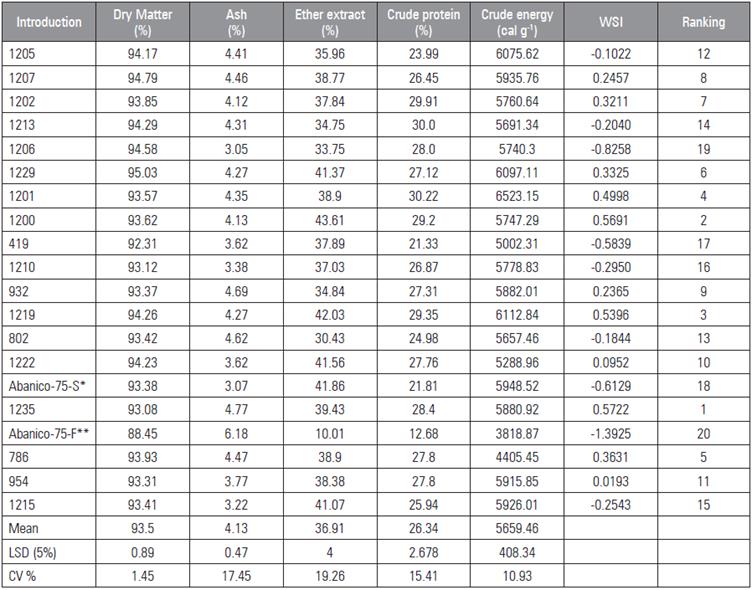
* Whole seed meal made from the fruit of cultivar Abanico-75 (reference). ** Defatted seed meal made from the fruit of cultivar Abanico-75 (reference).
Table 4 Nutritional value and weighted selection indexes (WSI) for defatted seed meal of 19 squash introductions and cultivar Abanico-75 (the latter used as the reference).
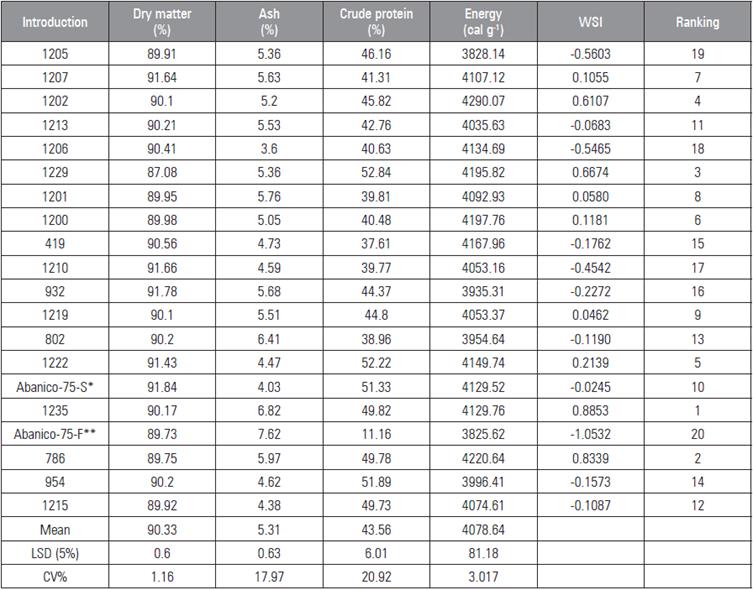
* Whole seed meal made from the fruit of cultivar Abanico-75 (reference). ** Defatted seed meal made from the fruit of cultivar Abanico-75 (reference).
In general, the average ash and CP contents of the WSM were lower than those of the DSM, while the CE was higher in the WSM than in the DSM. This was due to the fact that oil, the largest source of en ergy, was eliminated from the WSM during the ether extraction, whereas in the DSM, the mass ratios fa vored the remaining metabolites, especially starch and CP (Tab. 3 and 4).
The overall mineral content, represented by the ash content, in the WSM and DSM in this study was high er than the ash content in the squash WSM (3.9%) reported by Ortiz et al. (2009) and that of peanut seed meal (2.6%) reported by Pascual et al. (2006) (Tab. 3 and 4). The reference material, a WSM made from the fruit of cultivar Abanico-75, presented above-average mineral ash content values (6.18-7.62%), as compared with the WSM (4.13%) and DSM (5.31%) (Tab. 3).
The three introductions with the higher EE con tents were 1200 (43.61%), 1219 (42.03%) and Unapal Abanico-75 (41.86%). Based on this information and reports by Ortiz et al. (2009), squash seed can be con sidered an oleaginous raw material.
Of the 19 studied introductions, 70% presented an above-average EE content (36.9%) in the seeds (Tab. 3). According to Younis et al. (2000), the EE of squash seeds is higher than that of sunflower seeds (36%), except in the case of squash introduction 802 (30.43%), agreeing with results found by Roy (2000) when compared with maize (5% EE) and linseed (20.7% EE).
Of the studied squash introductions, 70% presented an above-average CP content in the seeds (average = 26.34%) (Tab. 3). The CP values were similar to or higher than those for peanut (Arachis hypogea), 26.0%; Canavalia grain (Canavalia ensiformis), 16-23%; cot ton seed (Gossypium spp.), 12-22%; and Nima bean (Phaseolus vulgaris), 16-20%. For the seed CE, 65% of the introductions presented above-average values (5659.46kcal kg-1), surpassing that of sunflower seed (5,353 kcal kg-1) (Arija et al., 1999) (Tab. 3).
The WSI for the nutritional value of the squash seeds showed that 57% of the introductions were above-average in several of the studied variables, with 1235, 1200, 1219 and 1201 ranking first (Tab. 3).
Of the introductions included in this study, 57% presented above-average CP values (43.5%) in the DSM, presenting higher values than palm kernel cakes (14%), cotton (29.5%), rapeseed (34.5%), co pra (21%) (Chatterjee and Walli, 2002) and Jatropha curcas fruits (Rodriguez et al., 2016). In addition, the CP value in the DSM of introductions 1205 (46.16%), 1229 (52.48%) and 1222 (52.22%) as well as that of cultivar Abanico-75 (51.33%) was higher than that of soybean meal (46%) (Tab. 4).
For the CE in the DSM, 52% of the introductions presented above-average values (4,078 cal g-1). Intro duction 1201 presented the highest energy content in the WSM (6,523.15 cal g-1) and introduction 1202 presented the highest energy content in the DSM ranked first in both the WSM and DSM, based on the (4,90.07 cal g-1) (Tab. 4). comprehensive weighted value.
Introductions 1235, 786, 1229 and 1202 ranked first based on the WSI, presenting outstanding nutritional values (Tab. 4).
Based on the data collected in this study, all of the WSMs and DSMs presented higher nutritional val ues than the raw materials on the market. This study aimed to determine which introductions could serve as potential parents in future breeding efforts and selection processes conducted by the university's Vegetable Research Program. Based on the WSI, those introductions presenting the best proximate per formance in terms of WSM were 1235, 1200, 1219, 1201, 954 and 786; in terms of the DSM, introduc tions 1235, 786, 1229, 1202 and 1222 had the best performance. Likewise, introductions 1235 and 786 ranked first in both the WSM and DSM, based on the comprehensive weighted value.
Fiber quality of whole seed and seed meal of squash introductions
Both food and animal feed industries require raw ma terial with minimal values of NDF, ADF and lignin, particularly in the case of animal nutrition, where the high digestibility of nutrients in ruminants and monogastric animals that present enzymatic diges tive processes is associated with a low NDF and ADF with respect to total fiber content. The RFV assigned to the WSM and DSM in Tab. 5 and 6 assumed that the high RFVs mean that these introductions have a high biological value. Based on the foregoing, the best introductions in terms of RFV for the WSM were 1229, 1200, 1201, 1219 and 1206 (Tab. 5).
Table 5 Relative feed value (RFV) of whole seeds of 19 squash introductions and cultivar Abanico-75 (the latter used as the reference).
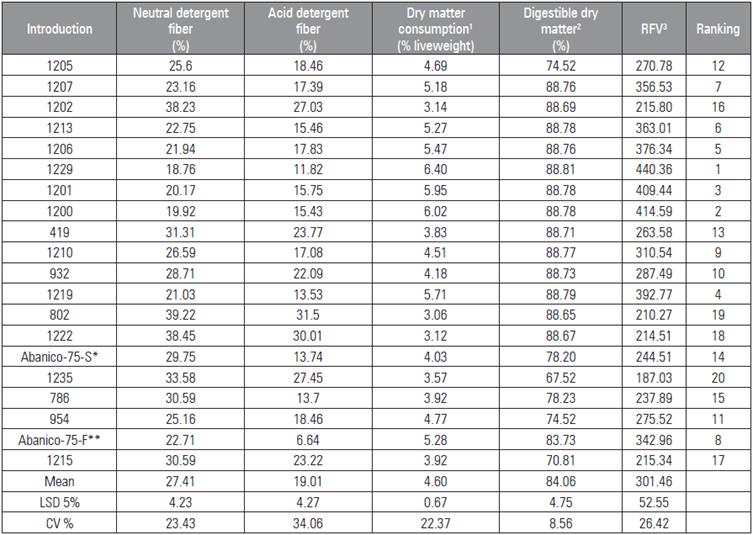
1 Estimated as 120 / (% neutral detergent fiber). 2 Estimated as 88.9 - (0.779 x % acid detergent fiber). 3 Estimated as (digestible dry matter x dry matter intake) / 1.29. * Whole seed meal made from the fruit of cultivar Abanico-75 (reference). ** Defatted seed meal made from the fruit of cultivar Abanico-75 (reference).
As indicated above, after the seed oil extraction, the DSM acquired a special biologic value because of its high protein content. However, what determines whether the RFV of the DSM is apt for cattle nutri tion is the level of fiber (NDF or ADF). Introduc tions 1229, 932, 1200, 786 and 954 ranked first for this variable (Tab. 6).
Table 6 Relative feed value (RFV) of defatted seed meal made from 19 squash introductions and cultivar Abanico-75 (the latter used as the reference).
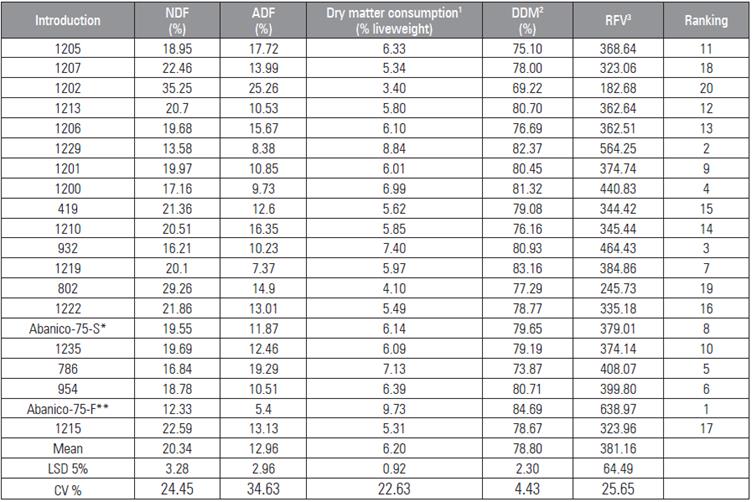
1 Estimated as 120 / (% neutral detergent fiber).
2 Estimated as 88.9 - (0.779 x % acid detergent fiber).
3 Estimated as (digestible dry matter x dry matter intake) / 1.29. * Whole seed meal made from the fruit of cultivar Abanico-75 (reference). ** Defatted seed meal made from the fruit of cultivar Abanico-75 (reference). NDF, neutral detergent fiber. ADF, acid detergent fiber. DDM, Digestible dry matter.
Based on the selected introductions, the recommen dation is to identify C. moschata parental materials with both a general combining ability and a specific combining ability for EE and CP in the WSM and for a high RFV in both the WSM and DSM (Ortiz et al., 2013).
A crossbreeding process should be carried out with C. sororia introductions 1202 and 954 to obtain su perior F2 segregants for oleaginous and protein grain (Ortiz et al. 2013).
CONCLUSIONS
The squash WSM and the DSM meal derived thereof presented a high nutritional value with the potential to replace protein and oleaginous grains in ruminant feed.
Of the introductions submitted to proximate analy sis to determine nutritional value, 10% of the C. so roria introductions (954 and 1215) and 26% of the C. moschata introductions (786, 1200, 1219, 1229 and 1235) ranked high in terms of quality.
Based on the RFV, introductions 1229, 1200, 1201, 1219 and 1206 were selected for the WSM, and 1206, 1229, 932, 1200, 786 and 954 were selected for the DSM.
In the case of C. moschata introductions 1200, 1201, 1206, 1213, 1219 and 1229, parents with both general and specific combining abilities for oil and CP con tents in the WSM and for high RFV in both the WSM and DSM should be identified.
A crossbreeding process should be carried out with C. sororia introductions 1202 and 954 to obtain F2 segregants for seeds with a high oil value in the WSM, as well as for a high RFV in the DSM.













